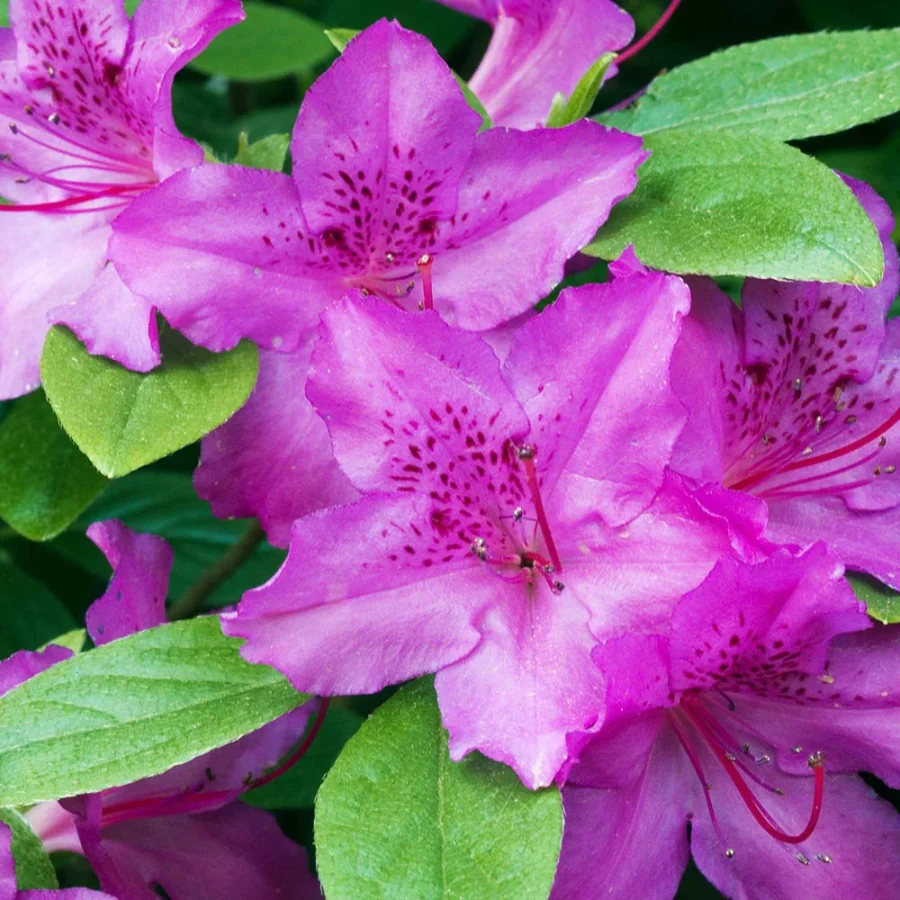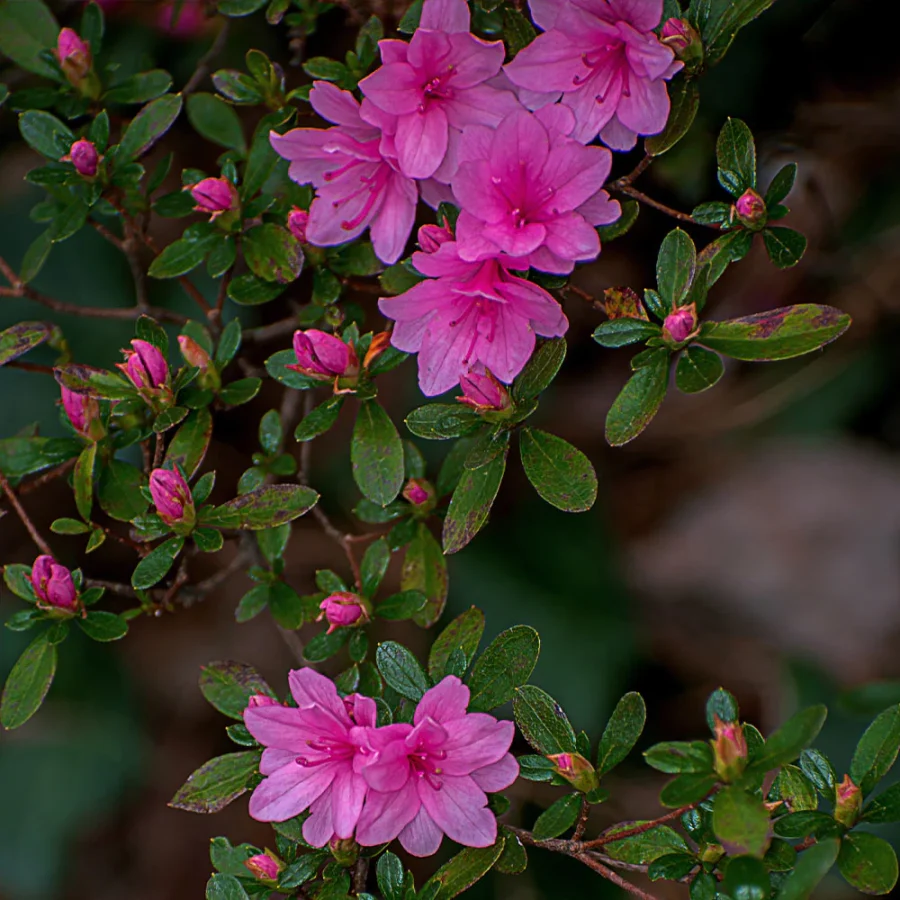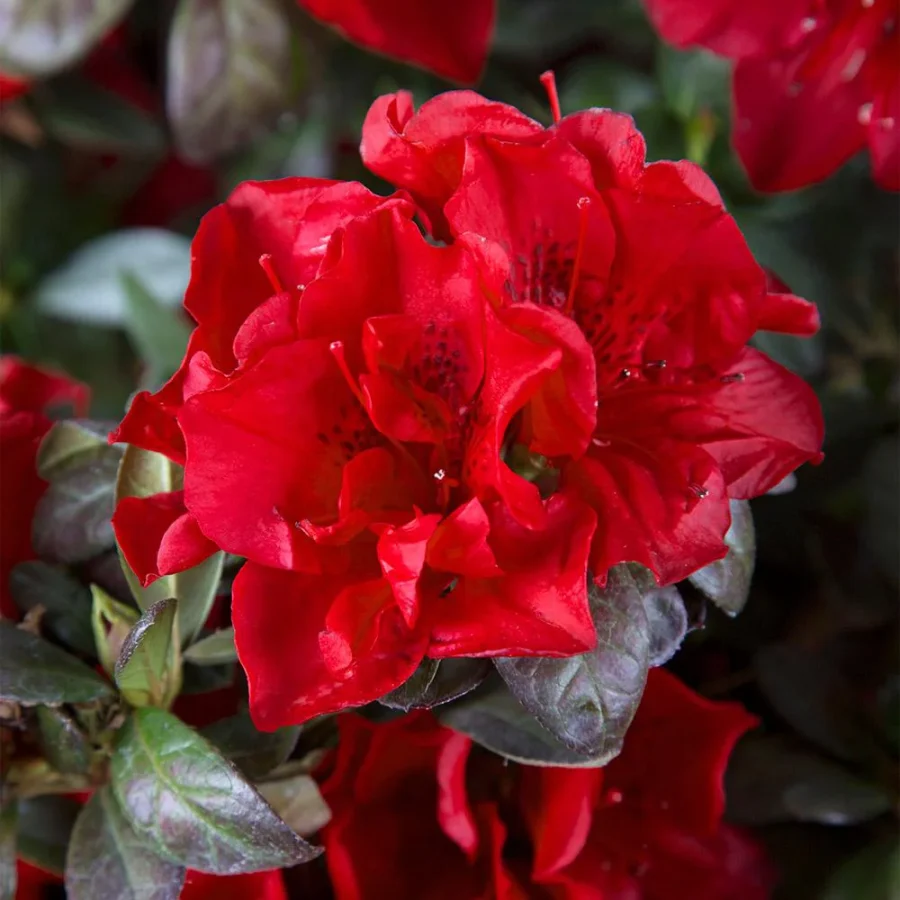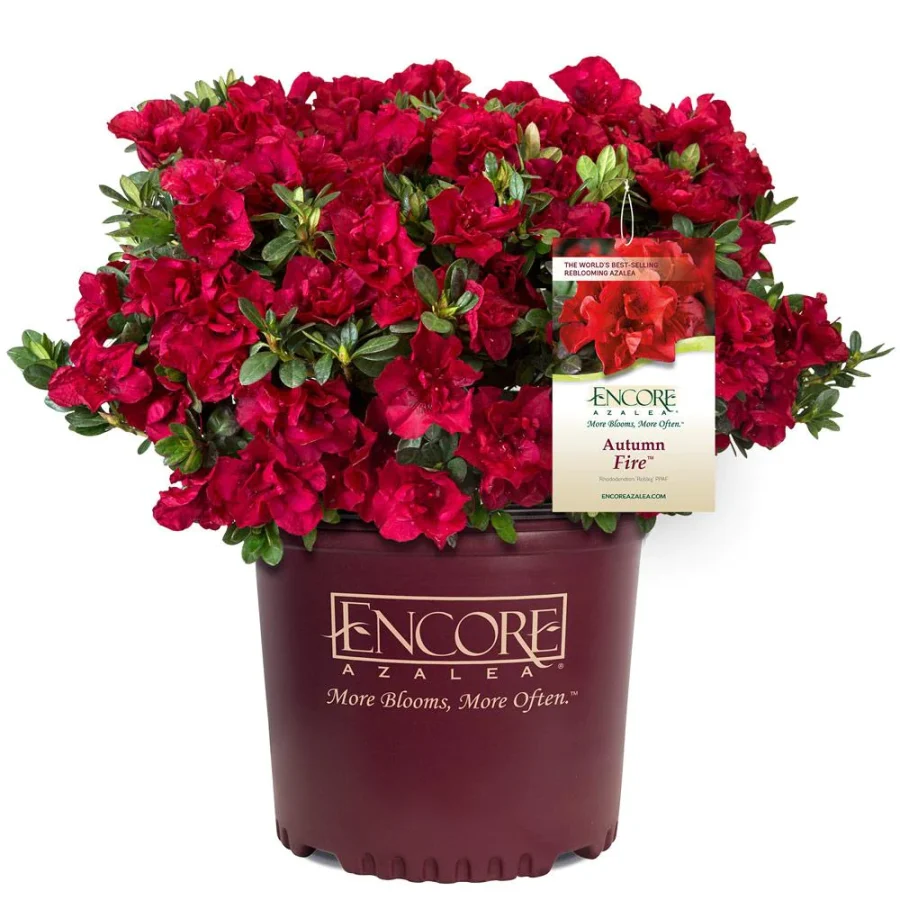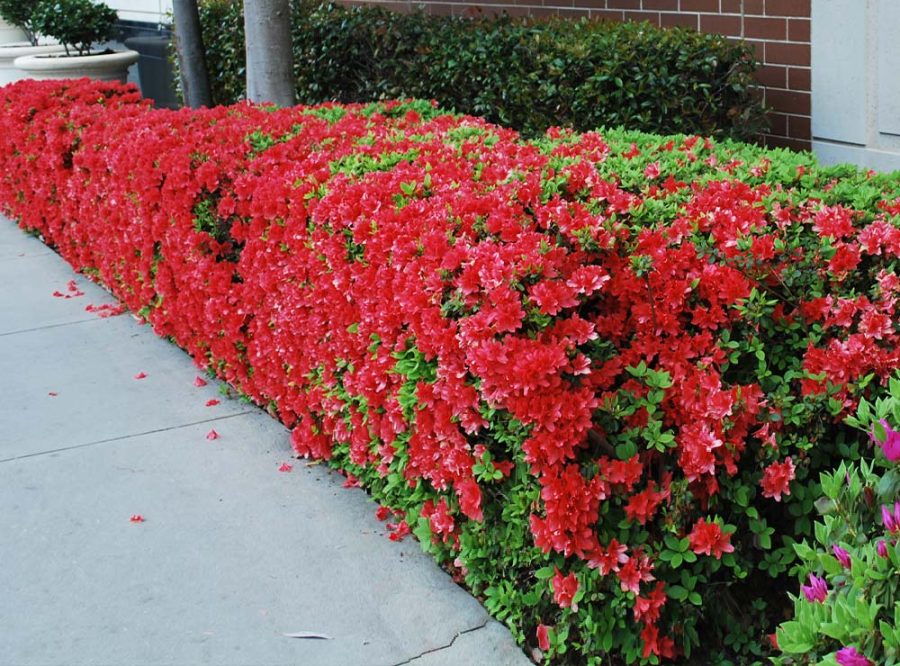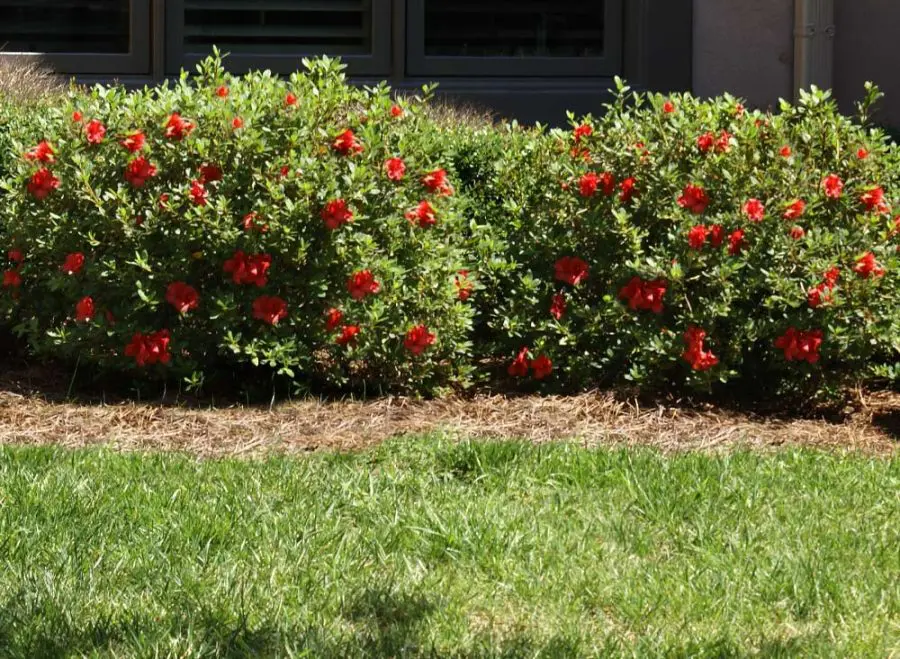This post contains affiliate links. If you buy something from one of our links we may earn a commission. Thanks
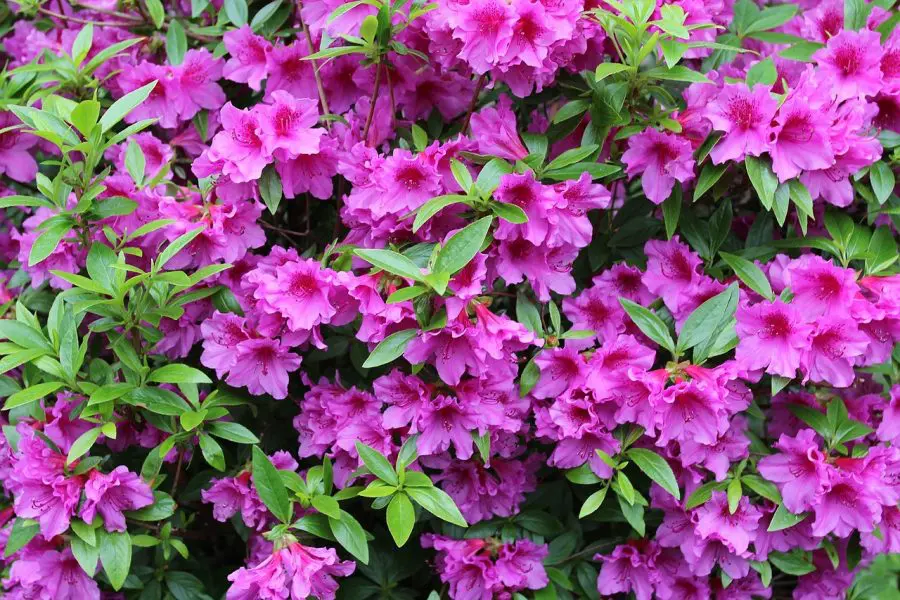
Welcome to our Indoor Azaleas Cheat Sheet! If you’re looking for expert advice on achieving stunning indoor Azalea blooms you’re in the right place.
Indoor Azaleas cheat sheet: Place in a bright, indirect light location, and maintain a consistent temperature between 60-75°F. Water when the soil feels dry to the touch but avoid waterlogging. Use acidic, well-draining soil and fertilize with a slow-release, acid-forming fertilizer. Mist leaves regularly to maintain humidity.
Welcome To Your Indoor Azaleas Cheat Sheet
Welcome to our Indoor Azaleas Cheat Sheet! If you’re looking for expert advice on achieving stunning indoor blooms, you’re in the right place.
We’ve compiled 10 essential tips and tricks for success and a bonus on seasonal care for your indoor azaleas.
Get ready to transform your space into a vibrant oasis of natural beauty.
Let’s dive in and unlock the secrets to flourishing indoor azaleas!
Placement and Lighting:
Bright Room Placement:
When caring for indoor potted Encore Azaleas, it’s crucial to choose the right spot. Place your container in a bright room near a window. Ensure the spot doesn’t get too cold on frosty nights.
Ideal Lighting Requirements:
Encore Azaleas thrive with morning direct sun and afternoon partial shade or bright indirect light all day. Consider the placement of your plant and the amount of natural light it receives.
Supplemental Lighting:
In areas with limited sunlight, you can provide supplemental lighting using grow lights. LED grow lights are an excellent choice, providing the necessary spectrum for optimal growth.
Temperature and Humidity:
Optimal Temperature Range:
Houseplant azaleas prefer temperatures around 60-65°F for optimal performance. Cooler temperatures can also help blooms last longer, so keep this in mind when positioning your plant.
Avoid Drafts and Extreme Temperatures:
Protect your indoor azaleas from drafts and temperature extremes. Avoid placing them near heating or cooling vents or in areas prone to sudden temperature fluctuations.
Humidity Considerations:
Azaleas thrive in humid environments. The hot, dry air from heating systems can be detrimental to your plant’s health.
Increase humidity by placing the pot on a tray of wet pebbles or using a room humidifier.
Misting as a Humidity Boost:
Periodic misting can help increase humidity, but be cautious not to overdo it.
Too much moisture on the leaves can lead to fungal diseases. Mist sparingly and avoid misting late in the day to allow foliage to dry before evening.
Watering and Moisture Levels:
Proper Moisture Balance:
Never let your indoor potted Encore Azaleas dry out, but be careful not to overwater.
The soil should be moist but not waterlogged. Consistency is key. Consider using a moisture meter to monitor soil moisture levels.
Water Quality:
Azaleas prefer slightly acidic soil. If your tap water is alkaline, consider using rainwater, distilled water, or acidifying agents to adjust the pH and provide the ideal growing conditions.
Weekly Submerging Technique:
To ensure proper hydration, try the weekly submerging technique also called bottom watering.
Submerge the entire pot in water once a week to allow the potting mix to rehydrate thoroughly.
Drain any excess water after a few minutes.
Mulching for Moisture Retention:
Apply a layer of organic mulch, such as pine bark or compost, around the base of your azalea.
Mulch helps retain moisture, regulate soil temperature, and prevent weed growth.
Container Selection and Preparation:
Choosing the Right Pot:
Select a container with drainage holes or drill your own to ensure proper drainage.
The pot should be 4-6 inches wider than the root ball to provide ample room for growth.
Importance of Drainage:
Good drainage is crucial for the health of your azaleas. It prevents waterlogging, which can lead to root rot.
Use a well-draining potting mix and add a layer of gravel or small stones at the bottom of the pot to enhance drainage.
Potting Mix Selection:
Choose a high-quality potting mix specifically formulated for acid-loving plants.
The mix should provide good aeration and moisture retention while allowing excess water to drain away.
Container Material:
Select a container made of a suitable material such as plastic, ceramic, or clay.
Each material has its advantages: plastic retains moisture better, ceramic provides better insulation, and clay allows for better airflow to the roots.
Preparing the Pot:
Before planting your azalea, clean and sterilize the pot to prevent the introduction of harmful pathogens.
Rinse the pot with a mixture of bleach and water, and allow it to dry completely before use.
Root Ball Positioning:
When planting, ensure the top of the root ball is slightly above the soil surface.
This prevents water accumulation around the base of the plant and reduces the risk of root rot.
Fertilization:
Understanding Nutrient Needs:
Azaleas have specific nutrient requirements. They benefit from a balanced fertilizer formulated for acid-loving plants.
Look for a product with an NPK ratio designed for azaleas, such as 10-10-10 or 15-15-15.
Fertilizing Schedule:
Begin fertilizing in early spring, after the flowering period is complete. Apply a slow-release fertilizer according to the manufacturer’s instructions.
Repeat the application in late spring and early fall to support healthy growth and blooming.
Avoid Over-Fertilization:
Too much fertilizer can damage azaleas. Follow the recommended dosage and avoid applying fertilizer when the plant is stressed, such as during extreme heat or drought.
Organic Fertilizer Options:
Consider using organic fertilizers like compost or well-decomposed manure. These provide a gradual release of nutrients and improve soil structure over time.
Mulch as a Natural Fertilizer:
Apply a layer of organic mulch around the base of the plant. As the mulch breaks down, it releases nutrients into the soil, providing a natural fertilization effect.
Pruning and Maintenance:
Pruning for Shape and Health:
Pruning is important for maintaining the shape and health of your indoor azaleas.
After the blooming period, trim any dead or damaged branches, and shape the plant as desired.
Use clean, sharp pruning tools to make clean cuts and minimize the risk of disease.
Pinching for Bushier Growth:
Pinch back the tips of new growth to encourage branching and create a bushier, more compact plant.
This promotes more abundant blooming and denser foliage.
Maintenance Tasks:
Regularly remove spent blooms to redirect energy toward new flower production.
Keep an eye out for pests, diseases, or signs of stress, such as yellowing leaves or wilting, and address issues promptly.
Cleaning and Disinfection:
Clean your azalea leaves gently with a soft cloth or sponge to remove dust and dirt.
Regularly clean the pots and trays to prevent the buildup of algae or pests.
Disinfect your pruning tools before and after use to prevent the spread of diseases.
Winter Care:
Winter Protection:
During the winter months, indoor azaleas may require extra care to protect them from low temperatures and dry indoor conditions.
Place them in a cooler room with indirect light and away from drafts.
Reduced Watering:
Adjust the watering frequency during winter to avoid overwatering.
Allow the soil to dry out slightly between waterings, as azaleas require less water during their dormant period.
Be cautious not to let the soil completely dry out, as this can cause stress to the plant.
Winter Insulation:
Insulate your azaleas by placing them away from cold windows or providing a layer of horticultural fleece around the pot to protect the roots from freezing temperatures.
Adequate Lighting:
Even during winter, azaleas benefit from receiving some natural or supplemental light.
If natural light is limited, consider using grow lights to provide sufficient light for the plants to maintain their health and prevent leggy growth.
Avoid Overfeeding:
Reduce or suspend fertilization during the winter months, as azaleas are in their dormant phase and do not require as many nutrients.
Resume regular fertilization in early spring when the plant begins to show signs of new growth.
Pest and Disease Prevention:
Common Pests:
Azaleas can be susceptible to pests such as aphids, scale insects, and spider mites.
Monitor your plants regularly for any signs of infestation, such as distorted leaves, sticky residue, or webbing.
Natural Pest Control:
Introduce beneficial insects like ladybugs or lacewings to help control aphids and other small pests.
Alternatively, use organic insecticidal soaps or neem oil sprays to combat common pests.
Disease Prevention:
Azaleas can be affected by diseases such as powdery mildew, leaf spot, or root rot.
To prevent these diseases, provide adequate air circulation, avoid overhead watering, and ensure proper drainage.
If necessary, treat with appropriate fungicides following the instructions carefully.
Regular Inspections:
Regularly inspect your azaleas for any signs of disease or pest activity. Prompt action can prevent the spread of pests or diseases and help maintain the health of your plants.
Companion Planting:
Complementary Flowering Plants:
Enhance the beauty of your indoor azaleas by pairing them with complementary flowering plants.
Consider plants with similar light and moisture requirements, such as ferns, impatiens, or cyclamen, to create a visually appealing and diverse display.
Texture and Foliage Contrast:
Combine azaleas with plants that have contrasting foliage textures or colors.
For example, the feathery fronds of ferns or the trailing vines of ivy can create an interesting visual contrast against the lush blooms of azaleas.
Seasonal Variations:
Choose companion plants that bloom at different times of the year to ensure a continuous display of color in your indoor garden.
Select plants with varying heights to create depth and visual interest.
Enjoying the Benefits:
Indoor Beauty:
The vibrant blooms and lush foliage of indoor azaleas bring natural beauty and a touch of elegance to any indoor space.
Enjoy the visual delight they provide and the positive ambiance they create.
Stress Reduction:
Indoor plants, including azaleas, have been shown to reduce stress and improve mood.
Their presence can create a calming environment, making them ideal for bedrooms, living rooms, or office space
Health Benefits:
Indoor azaleas can help purify the air by removing toxins and increasing oxygen levels.
This can contribute to improved indoor air quality and overall well-being.
Conclusion: Indoor Azaleas Cheat Sheet
With these 10 tips and tricks, you’re well-equipped to succeed in growing beautiful and healthy indoor azaleas.
From proper placement and lighting to understanding watering and fertilization needs, each aspect contributes to the overall success of your azalea journey.
Embrace the beauty and rewards of cultivating indoor azaleas, and enjoy.
We have added a bonus section for you.
Elevate Your Indoor Azalea Experience: Pollination, Troubleshooting, and Seasonal Care
Are you ready to take your indoor azalea journey to the next level?
In this comprehensive guide, we’ll delve into the intricacies of azalea care and exploration, covering topics that will empower you to become an expert in indoor azalea cultivation.
From mastering the art of pollination and seed production to troubleshooting common issues and providing season-specific care, you’ll gain valuable insights to nurture healthy, vibrant azaleas year-round.
Let’s embark on this captivating adventure and unlock the full potential of your indoor azalea oasis.
Pollination and Seed Production:
Understanding the process of pollination and seed production in indoor azaleas opens up exciting possibilities for expanding your plant collection.
By mastering the art of pollination, you can propagate new azaleas from seeds and witness the marvel of their life cycle.
In this section, we’ll explore the fascinating world of pollination, providing step-by-step guidance on hand-pollination techniques and the collection and sowing of azalea seeds.
Azalea Pollination:
Azaleas, like many flowering plants, rely on pollinators for successful reproduction.
However, in an indoor environment, natural pollination may be limited.
By utilizing hand-pollination techniques, you can ensure the transfer of pollen between flowers and achieve fruitful results.
To begin, identify flowers at the appropriate stage of maturity, with fully opened petals and visible stamens.
Gently touch the anthers with a small brush or cotton swab to collect the pollen.
Then, carefully transfer the collected pollen to the stigma of another flower, mimicking the natural process of pollination.
Collecting and Sowing Seeds:
Once successful pollination occurs, azalea flowers develop seed pods that contain the potential for new plant life.
To collect azalea seeds, wait until the seed pods turn brown and begin to split open.
Harvest the pods and extract the small, dark seeds within. Next, prepare the seeds for germination by treating them to break their dormancy.
Some azalea seeds benefit from a period of stratification, which involves chilling them in a moist medium in the refrigerator for several weeks.
After stratification, sow the seeds in a well-draining potting mix, lightly covering them with a thin layer of soil.
Maintain consistent moisture and warmth, and be patient as the seeds germinate and develop into seedlings.
Dealing with Common Problems:
While indoor azaleas are generally resilient, they can occasionally encounter problems that affect their health and appearance.
By being aware of common issues and knowing how to address them, you can ensure the continued vitality of your plants.
In this section, we’ll delve into some of the most common problems azaleas may face indoors and provide practical solutions for overcoming them.
Leaf Drop:
Leaf drop can be a distressing sight for any plant enthusiast. Several factors can contribute to this issue, including overwatering, underwatering, temperature fluctuations, or pest infestations.
To tackle leaf drop, assess the watering habits and adjust them accordingly. Avoid both waterlogged and excessively dry soil conditions.
Ensure the plant is situated in a suitable temperature range, avoiding sudden temperature changes.
Additionally, inspect your azalea for signs of pests, such as aphids or spider mites, and promptly address any infestations using appropriate organic or chemical control methods.
Yellowing Leaves:
Yellowing leaves can indicate underlying problems that require attention.
Nutrient deficiencies, pH imbalances, inadequate lighting, or pest damage can all contribute to yellowing leaves in indoor azaleas.
To address this issue, first, assess the soil pH and adjust it if necessary to ensure it falls within the preferred range for azaleas (slightly acidic, pH 5.5 to 6.0).
If nutrient deficiencies are suspected, provide a balanced fertilizer formulated specifically for acid-loving plants.
Ensure your azalea receives adequate lighting, as insufficient light can weaken the plant and cause yellowing leaves.
Consider supplementing with artificial grow lights if natural light is limited.
Finally, inspect your plant for signs of pests such as aphids, mealybugs, or scale insects, as their feeding can lead to leaf discoloration.
Treat any infestations using appropriate control methods, such as insecticidal soap or neem oil.
Pest Control:
Pests can pose a threat to the health and vigor of your indoor azaleas. Common pests that may affect azaleas include aphids, mealybugs, scale insects, and thrips.
Regularly inspect your plants for signs of infestation, such as distorted leaves, sticky residue, or visible insects.
If you spot pests, take immediate action to control their population. Depending on your preference, choose between organic or chemical control methods.
Organic options include insecticidal soaps, neem oil sprays, or introducing beneficial insects like ladybugs, which can help naturally control the pest population.
Follow the instructions on the product labels carefully and apply treatments as needed.
Additionally, practicing good plant hygiene, such as regularly cleaning leaves and maintaining a clean growing environment, can help prevent pest infestations.
Dwarf Azalea Varieties For Indoors:
The world of azaleas is rich with diversity, offering a wide range of varieties to suit different preferences and growing conditions.
Understanding the characteristics and care requirements of various azalea varieties can help you make informed choices for your indoor garden.
In this section, we’ll highlight some popular indoor azalea varieties and guide you in selecting the right one for your space.
Popular Indoor Azalea Varieties:
There are several azalea varieties that thrive indoors, each with its unique colors, bloom times, and growth habits. Some popular choices include:
‘Karen’ (Encore Azalea):
You can buy your Karen Azalea here
This variety showcases beautiful, ruffled pink blooms that rebloom throughout the year.
Renowned Floral Favorite: The Hardy Karen Azalea Shrub
What makes the Karen Azalea Shrub a standout?
A much-loved choice among garden enthusiasts, the Karen Azalea is cherished for its strikingly beautiful flowers, robustness, and the eye-catching contrast of its lush lavender-pink blossoms and vivid green leaves.
The Karen Azalea brings year-round aesthetic appeal to any garden or landscape.
Each spring, it delights with a profusion of resplendent pink blossoms, which transform into a deep burgundy hue come autumn.
Its verdant leaves remain vibrant throughout the year, offering perennial greenery.
Moreover, this azalea variety is a favorite of hummingbirds and butterflies, turning your outdoor space into a lively and colorful sanctuary.
For optimal growth, the Karen Azalea should be planted in clusters under partial sunlight—it makes an excellent border addition to garden beds.
It thrives in well-drained, acidic soil, making it a suitable choice for serene zen gardens, quaint cottage gardens, and other peaceful landscapes.
Furthermore, this plant’s hardiness shouldn’t be underestimated—it requires minimal maintenance and is capable of surviving in as low as Zone 4.
Mature Height: Between 2 and 4 feet Mature Width: Ranging from 3 to 5 feet
Sunlight: From full sun to partial shade
Growth Rate: Moderate
Botanical Name: Azalea x ‘Karen’
Ideal Growth Zones: 4-9 outdoors
| Mature Height: | 2-4 ft. |
| Mature Width: | 3-5 ft. |
| Sunlight: | Full-Partial |
| Growth Rate: | Moderate |
| Botanical Name: | Azalea x ‘Karen’ |
| Does Not Ship To: | AZ |
| Grows Well In Zones: | 4-9 outdoors |
 Growing Zones: 4-9 outdoors (hardy down to -20℉)
Growing Zones: 4-9 outdoors (hardy down to -20℉)
Autumn Fire Encore Azalea Shrub
Captivating Red Flowers Endure for Several Months. What Makes Autumn Fire Encore Azalea Shrubs Special?
Robert Lee, a globally recognized azalea cultivator, has astounded us once again with his latest marvel, the Autumn Fire Azalea.
The promise of this creation is to surpass all previous bloomers in terms of flowering performance.
The Encore Azaleas project, initiated by Lee in the 1980s, had the primary focus of developing azalea varieties that bloom in the fall and demonstrate winter hardiness.
The Autumn Fire Encore Azalea, like other plants in the Encore Azalea series, is known for its ability to bloom multiple times throughout the year, typically from spring through fall.
This extended blooming period, which includes the fall season, sets these azaleas apart from many traditional azalea varieties that only bloom in the spring. a departure from the fleeting spring blooms of traditional azaleas.
The result was the creation of 28 varieties that bloom recurrently.
The Autumn Fire marks the 29th variety, and it’s predicted to be the most dramatic yet.
The plant boasts magnificent 3-inch cherry-red blooms, set against a backdrop of rich green leaves.
What makes the Autumn Fire truly extraordinary is its ability to charm not only during the spring but also deep into the fall season.
Be the pioneer in your neighborhood to cultivate this distinctive and flamboyant azalea!
| Mature Height: | 2-3 ft. |
| Mature Width: | 2-3 ft. |
| Sunlight: | Full-Partial |
| Growth Rate: | Moderate |
| Botanical Name: | Rhododendron ‘Autumn Fire’ |
| Does Not Ship To: | AZ |
| Grows Well In Zones: | 6-9 outdoors |
| Your Growing Zone: | 8 |
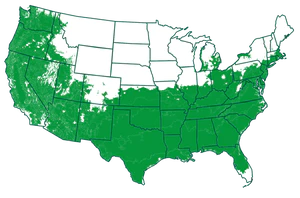
Growing Zones: 6-9 outdoors (hardy down to 0℉)
Choosing the Right Variety:
When selecting an azalea variety for indoor cultivation, consider factors such as available space, desired flower color, and personal preferences.
Some varieties are more compact and suitable for smaller containers, while others may require larger pots to accommodate their growth.
Pay attention to their light and moisture requirements as well.
Research specific varieties to determine their ideal conditions and choose those that align with your indoor environment.
Remember to consider bloom times to ensure a continuous display of flowers throughout the year.
Troubleshooting Guide:
As an azalea enthusiast, encountering challenges along the way is inevitable.
However, armed with knowledge and troubleshooting skills, you can overcome these hurdles and ensure the health and well-being of your indoor azaleas.
In this section, we’ll provide a comprehensive troubleshooting guide, addressing common issues and offering effective solutions.
Common Azalea Issues:
Azaleas can face various issues that can impact their growth and overall appearance. Let’s explore some common problems and their remedies:
Wilting:
If your azalea exhibits wilting leaves or stems, it may be a sign of inadequate watering or root-related problems.
Ensure the soil is consistently moist but not waterlogged. Adjust your watering schedule accordingly.
If the roots are tightly packed, consider repotting the azalea into a larger container with fresh well-draining soil.
Bud Drop:
Bud drop can occur due to inconsistent environmental conditions, such as extreme temperature fluctuations or dry air.
Maintain a stable indoor climate, avoiding sudden temperature changes.
Use a humidifier or place the pot on a tray filled with water and pebbles to increase humidity around the plant.
Fungal Diseases:
Azaleas are susceptible to fungal diseases like powdery mildew or root rot.
To prevent these issues, ensure proper air circulation around the plant and avoid overwatering.
If fungal infections occur, treat them with appropriate fungicides and adjust your watering practices to prevent future outbreaks.
Yellowing or Browning Blooms:
The vibrant blooms of azaleas can sometimes exhibit yellowing or browning, affecting their aesthetic appeal. Several factors can contribute to this issue:
Inadequate Light:
Insufficient light can lead to weakened blooms and discoloration. Azaleas thrive in bright, indirect light.
If your plant is not receiving enough light, consider supplementing with artificial grow lights or relocating it to a spot with better lighting conditions.
Nutrient Deficiencies:
A lack of essential nutrients, particularly iron, can cause yellowing blooms.
Use a balanced, acid-loving plant fertilizer that includes micronutrients like iron to ensure optimal nutrition for your azaleas.
pH Imbalances:
An incorrect pH level in the soil can affect nutrient availability and lead to bloom discoloration.
Test the pH of the soil and adjust it within the recommended range of 5.5 to 6.0 using appropriate soil amendments or acidifying agents.
Transplanting and Repotting Tips:
Transplanting or repotting your indoor azaleas is sometimes necessary to promote healthy growth. Here are some essential tips to ensure a successful transition:
Timing:
The best time to transplant or repot azaleas is during the dormant period in late winter or early spring before new growth emerges.
Root Pruning:
If the roots have become tightly bound within the pot, gently loosen them by pruning the outer roots. This process stimulates new root growth and prevents root binding.
Proper Pot Selection:
Choose a pot that is slightly larger than the current one, ensuring it has drainage holes to prevent waterlogging. Use a well-draining potting mix formulated for acid-loving plants.
Watering and Care After Repotting:
After repotting, water the azalea thoroughly and provide consistent care to minimize stress. Place the plant in a suitable location with the right lighting and temperature conditions.
By troubleshooting and addressing these common issues, you can maintain the health and vitality of your indoor azaleas, ensuring they thrive in their indoor environment.
Seasonal Care: Azalea Care Through The Seasons
Providing proper seasonal care for your indoor azaleas is essential to support their growth, health, and blooming potential throughout the year.
In this section, we’ll guide you through the specific care requirements for each season, ensuring that your azaleas receive the attention they need to flourish.
Spring Care:
As spring arrives, your indoor azaleas awaken from their winter dormancy.
Follow these care tips to promote healthy growth and vibrant blooms:
Pruning and Shaping:
After the spring bloom cycle, prune your azaleas to remove any dead or damaged branches.
Shape the plant as desired, but avoid excessive pruning, as it may reduce the number of blooms.
Fertilization:
Apply a slow-release, acid-loving plant fertilizer in early spring to provide the necessary nutrients for new growth.
Follow the product instructions for the correct application rate.
Pest Management:
Monitor your azaleas for pests such as aphids or spider mites. If an infestation is detected, use appropriate control methods like insecticidal soap or neem oil to protect your plants.
Watering:
Water your azaleas thoroughly, ensuring the soil remains consistently moist but not waterlogged.
Adjust the watering frequency based on the plant’s needs and the moisture level of the soil.
Summer Care:
During the summer months, azaleas may require extra attention to combat heat stress and maintain their health. Follow these tips for summer care:
Shade and Sun Protection:
Protect your azaleas from intense afternoon sun by providing shade during the hottest part of the day.
This can be achieved by placing them in a location with partial shade or using shading devices like umbrellas or shade cloths.
Adequate Watering:
As temperatures rise, azaleas may require more frequent watering to prevent the soil from drying out.
Monitor the moisture level of the soil and adjust your watering schedule accordingly, ensuring the roots receive enough moisture without becoming waterlogged.
Humidity Management:
Maintain adequate humidity levels around your azaleas by placing them on trays filled with water and pebbles or using a room humidifier.
This helps to counteract the drying effects of air conditioning or hot, dry summer air.
Fall Care:
Fall is a transitional season for indoor azaleas, preparing them for dormancy. Follow these care tips to support their transition:
Reduced Watering:
Gradually reduce the frequency of watering as the temperatures and light levels decrease.
Allow the top inch of soil to dry out slightly between waterings.
Fertilization:
Avoid fertilizing your azaleas in the fall. This allows them to enter dormancy without promoting excessive new growth.
Pest Prevention:
Inspect your azaleas for any signs of pests or diseases. Treat any issues promptly before the plant enters dormancy.
Winter Care:
During the winter months, azaleas go into dormancy. Follow these care guidelines to ensure their health and survival:
Reduced Watering:
Water your azaleas sparingly during winter, allowing the soil to partially dry out between waterings. Overwatering can lead to root rot.
Temperature and Light:
Keep your azaleas in a cool location with temperatures between 40-50°F (4-10°C). Provide them with indirect light or place them near a window with bright, filtered light.
Protection from Freezing:
If your area experiences freezing temperatures, protect your azaleas by moving them away from cold drafts or placing them in a slightly warmer location, such as a garage or basement.
Wrapping the pots with insulation material or covering the plants with frost blankets can provide additional protection.
Minimal Pruning:
Avoid significant pruning during winter, as it can stimulate new growth that may be susceptible to cold damage.
Instead, focus on removing any dead or diseased branches if necessary.
Monitoring:
Keep a close eye on your azaleas during winter, checking for signs of stress or pest infestations.
Address any issues promptly to ensure the plant’s well-being.
By following these seasonal care guidelines, you’ll provide the optimal conditions for your indoor azaleas, allowing them to thrive and delight you with their beauty throughout the year.
Azalea Care FAQs
Taking care of indoor azaleas may seem complicated, but with the right information, it’s easier than you might think.
These beautiful flowering plants thrive when certain conditions are met, and they can make a splendid addition to any indoor space.
From lighting requirements to watering schedules, many gardeners have questions about how to keep their azaleas looking their best.
Let’s dive into some frequently asked questions to clarify some common concerns.
Q: How often should I water my indoor Azaleas?
A: Water when the soil feels dry to the touch, but avoid waterlogging. Overwatering can lead to root rot.
Q: What type of soil is best for Azaleas?
A: Azaleas prefer acidic, well-draining soil. A mix specifically formulated for acid-loving plants will work well.
Q: Do Azaleas need a lot of light?
A: Indoor Azaleas do best in bright, indirect light. Too much direct sunlight can scorch the leaves, while too little light may cause poor blooming.
Q: Should I mist my Azaleas?
A: Yes, misting the leaves regularly can help maintain the humidity that Azaleas love. Alternatively, you can place a tray of water near the plant to boost humidity.
Azalea Care Through The Seasons Final Thoughts
Congratulations! You have now become well-versed in the art of caring for indoor azaleas.
By implementing the tips and techniques covered in this guide, you can create a flourishing indoor azalea oasis that brings joy and beauty to your space year-round.
From understanding the intricacies of pollination to troubleshooting common problems, and providing seasonal care, you have gained the knowledge to nurture healthy, vibrant azaleas.
Remember, each azalea is unique, and it may take some experimentation to find the perfect balance of light, water, and care for your specific plant.
Pay attention to your azaleas’ needs, observe their responses, and make adjustments accordingly.
With patience, dedication, and a little bit of green thumb magic, your indoor azaleas will reward you with their stunning blooms and lush foliage.
So, go ahead and embark on this rewarding journey of indoor azalea cultivation.
Enjoy the process, learn from your experiences, and watch your azaleas flourish in your care. Happy gardening!
Read more about Keeping Indoor Plants For Improved Lifestyle












